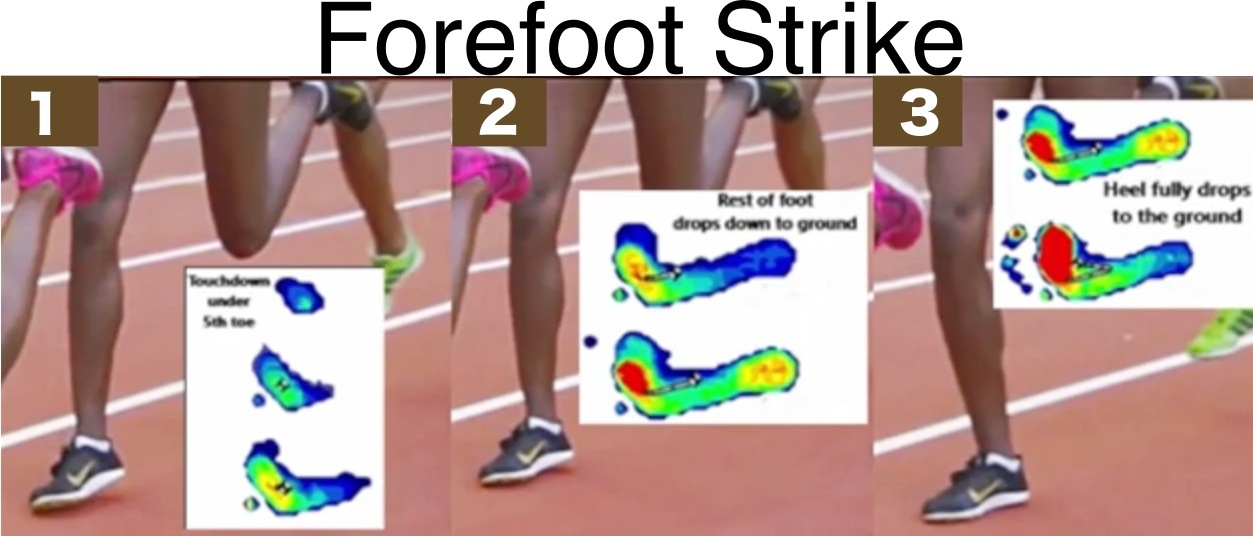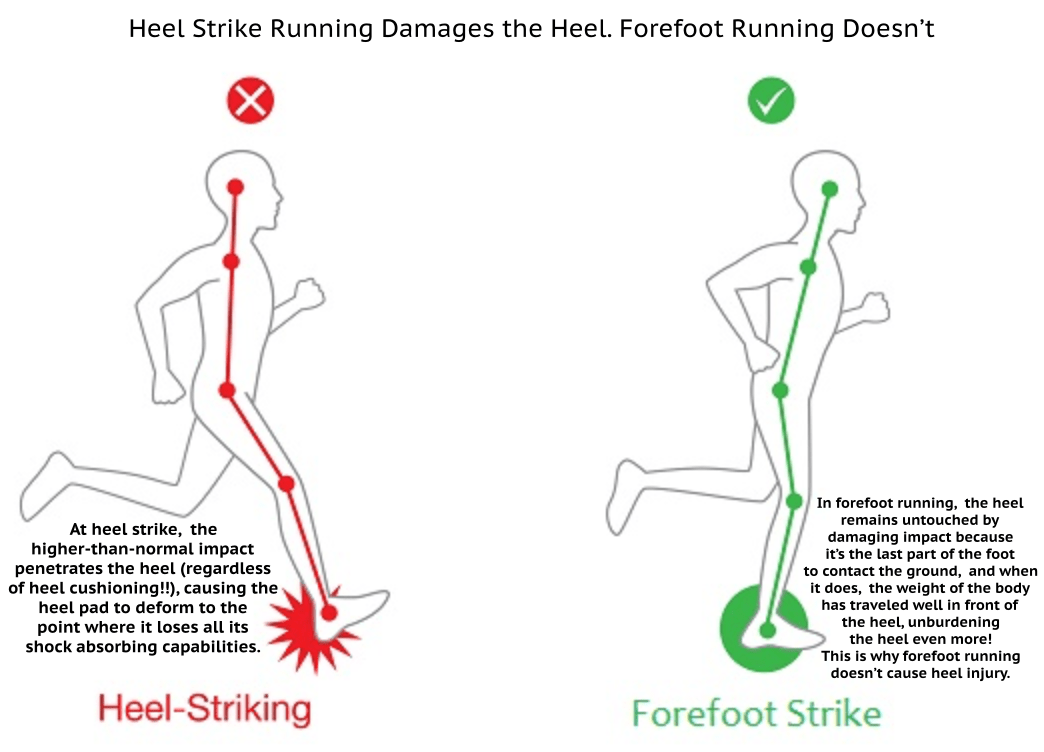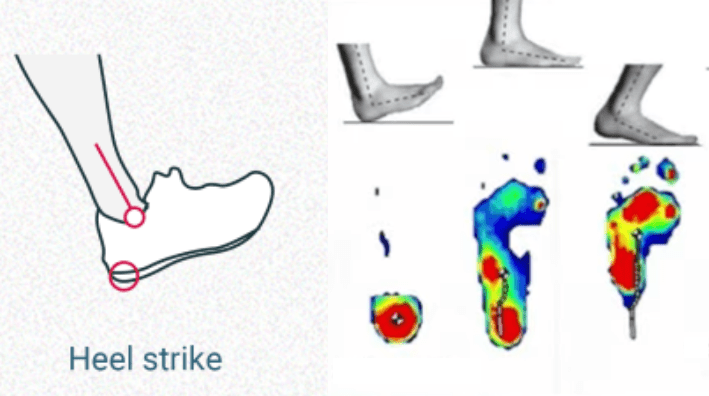A common injury in heel strike running is heel injury because the heel is the first point of the foot to strike the ground where impact is always higher-than-normal than forefoot running.
In forefoot running, net impact is significantly lower, and also, the heel is the last part of the foot to contact the ground, and when it does, the bodyweight has travelled well in front of the heel, which is why there’s no harmful impact penetrating the heel.

It turns out that heel strike running is the only significant producer of the damaging impacts that injures the heel. In following the evidence for this, a study in the Journal of Biomechanics, confirmed that the human heel pad is not durable enough to dampen the high burst in collisional impact that is always produced when striking heel-first when running, and cushioned heeled running shoes are not fully effective at damping impact either!
When it comes to walking with a heel strike, the heel pad was found to be perfectly capable of dampening the minor impact, but when running with a heel strike, especially at faster speeds, impact dramatically increased on the heel to the point where blood flow in the heel pad became so low that the heel pad lost all of its impact absorption properties.
Similar research in the Journal of Biomechanics also discovered that the shock absorber in the heel pad, known as the venous plexus, completely deformed which amplified impact onto the shins in long distance runners who were heel strikers:
- venous congestion, which is a metric of hydro-mechanical shock in the heel pad, remained normal when heel strike walking, but decreased when heel strike running
- heel strike runners showed decreased venous congestion of the venous plexus, indicating a loss of hydro-mechanical shock absorption in the heel pad
- because dampening properties of a system is related to the rate of deformation, the reduced dampening effect of the heel pad suggested a higher rate of deformation
- dampening effect of the heel pad venous plexus was no longer observed at faster speeds during heel strike running
What is more, the study found that heel strike running significantly reduced venous congestion (heel pad venous congestion refers to the over-filling of the blood which serves to dampen impact when walking), causing collisional impact to penetrate through the heel and up through the tibia, resulting in greater peak transient tibial deceleration (more opposing forces on the shins).
No Luck with Cushioned Running Shoes
A running shoe with the thickest cushioned heel dampens the magnitude of the vertical ground reaction force (i.e. the burst in collisional impact) at heel strike by only 10%! More is therefore needed to protect the heel from injury when running with a heel strike, which is why the most optimal, sustainable solution is to switch to forefoot running, and avoid heel striking altogether.

Landing forefoot-first then allowing your heel to drop all the way down to the ground has been shown to spread impact pressure best over the foot because it provides more surface to spread impact on, instead of a burst of excessive pressure hitting the heel, like in heel strike running.
By the time the heel drops to the ground in forefoot running, the impact pressure at the heel is barely measurable because the entire weight of the body has already shifted farther head of the heel (shown above) This is why forefoot running gives you better results in avoiding heel injuries. Its really that simple!
Full-on heel protection isn’t just one upside to forefoot running. Forefoot running is also safer for the shins, knees, hips and lower back! Here’s more on why forefoot running protects against so many injuries, the injuries caused by heel strike running!
References:
De Clercq D., Aerts P, Kunnen M. The mechanical characteristics of the human heel pad during foot strike in running: an in vivo cineradiographic study. J Biomech (1994); 27(10):1213-22.
Wearin et al. Force-deformation properties of the human heel pad during barefoot walking. Med Sci Sports Exerc (2014); 46(8):1588-94.
Weijers RE., Kessels AG and Kemerink GJ. The damping properties of the venous plexus of the heel region of the foot during simulated heel strike. J Biomech (2005); 38(12):2423-30

If you’d like, you can support Run Forefoot and help keep it going by making a donation in any amount of your choosing:

Or, you can also support Run Forefoot by shopping at the following top minimalist shoes brands, and be sure to bookmark the links:
Be Lenka: https://www.dpbolvw.net/click-7600968-14330828
FeelGrounds: https://www.feelgrounds.com/?p=RunForefoot
Xero Shoes: https://xeroshoes.com/go/Run_Forefoot
Iguaneye: https://www.iguaneye.com/?ref=8tfXVc92
Soft Star Shoes: https://shrsl.com/3mp1b
Wilding Shoes: https://bit.ly/3lIygQP
Earth Runners: https://earthrunners.com/?rfsn=6763579.f7f9c9
Vivobarefoot: https://shrsl.com/3kvih
Zappos: https://goo.gl/J1CeAd
Bretta Riches
BSc Neurobiology; MSc Biomechanics candidate, ultra minimalist runner & founder of RunForefoot. I was a heel striker, always injured. I was inspired by the great Tirunesh Dibaba to try forefoot running. Now, I'm injury free. This is why I launched Run Forefoot, to advocate the health & performance benefits of forefoot running and to raise awareness on the dangers of heel striking, because the world needs to know.
Latest posts by Bretta Riches (see all)
- Does Foot Strike Really Matter in Running? YES! - 17/04/2024
- Heel Lifts Increase Injury in Runners - 16/04/2024
- Are Minimalist Shoes Good for Seniors? YES! - 14/04/2024


